

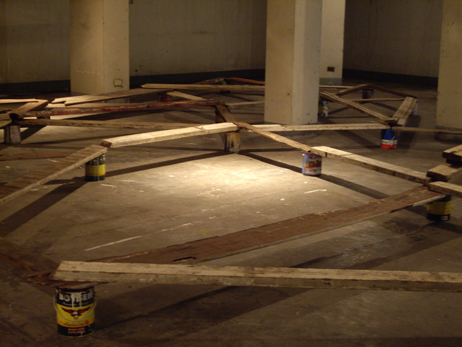
Little has been said or theorised about conceptual practices in the region, much less of its history. Yet, this is what artist and research, Ringo Bunoan, sets out to do in ‘Archiving Roberto Chabet’, which is held in the Cellar Gallery and Basement B of University of Philippines Vargas Museum, from 3 March – 4 April 2009.
To represent or archive something as abstract and intangible (when you get right down to it) as conceptual art, some of the main questions that surface revolves around the re-reading of the artist’s practice and the range of interpretative possibilities it may present for a new generation of audience.
Quoting from Stewart Home, ‘The world cannot be recorded. It can only be remade’, Bunoan takes to task the difficult question of retrieving from history a model of art-making (and thinking) that can still reinvent itself and assert its relevance not only as a historical anecdote but also as an applicable practice today.
To many Filipino artists, Roberto Chabet is considered as the grandfather of conceptual art in the Philippines (much like Malaysia’s conceptual grandfather figure, Redza Piyadasa). His tenure-ship at the University of Philippines over the last thirty years have resulted in a conceptual legacy that includes painters, installation artists, video artists, etc. Many of them are recognised internationally today as successful artists in their own right.
This homage to Roberto Chabet pays tribute to the artist by working within, what Bunoan calls, ‘the cracks in the narrative’. The presented works consist of reconstructions of Chabet’s works that have never been realised and those that have escaped documentation.
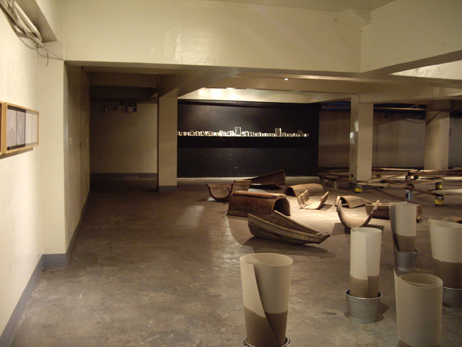
The inventory includes, ‘an installation made out of old wooden planks propped on empty paint cans, similar to those makeshift bridges when there is a flood; tin-framed mirrors lined up on a shelf, to reference the manifold of reflections; and rolled-up chipboards soaking in water in G.I. buckets, a response to a comment by painter Lee Aguinaldo. Bunoan also re-constructed Sudden School, a set of undocumented drawings made by Chabet based on the drawings of his nephew. Chabet’s own wooden dug out Boats are also included; this time two boats are shown, both cut into 5 sections and without the neon arrows in the original installation.’ (Press release, 2009)
Moreover, a glass door separates the viewer from the gallery, a tactic employed by Chabet in an exhibition of his in the 70s, specifying the perspective in which the audience may access the work. Just as this framing address the temporal disjuncture within Bunoan’s archival impulse, it also underscores the unbridgeable distance that is structurally embedded in any conceptual practice, a mystifying and hermetic frame of mind that Chabet calls ‘no place’, or an ‘elsewhere’.
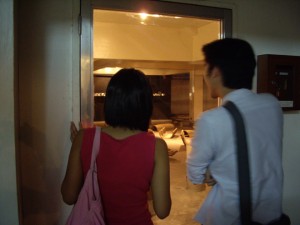
In the adjoining room, documentations of Roberto Chabet collected throughout Bunoan’s Asia Art Archive funded research are displayed alongside a scanner, which she used to digitise slide images of Chabet’s works.
ARTERI speaks to Ringo Bunoan to understand the importance of this project in relation to the systems and politics that govern our culture, memory and history.
What is the impetus behind ‘Archiving Roberto Chabet’?
I’ve been archiving the work of Chabet for over a year, as part of my research for AAA (Asia Art Archive). While we have gathered a lot of important primary documentation of his work, it is still incomplete, simply because not all of his works have been documented. The exhibition is a reflection on some of these ‘gaps’, the ‘missing’ parts of his story.
Can you tell us a bit more about Roberto Chabet and what are his contributions to contemporary art in the Philippines?
Chabet’s work questions modernity from a conceptual framework or way of thinking. Highly allegorical, his drawings, collages, sculptures and installations critique conventional modes of representation. He broke away from the rigid formalism that was the standard in Manila in the 60s, utilizing different forms and materials to articulate his idea of an art that is grounded on the displacement of meaning. It wasn’t exactly ‘theorized’ here then, but from early on, he was already talking about deconstruction.
Chabet taught for nearly 30 years at the UP College of Fine Arts, teaching generations of artists, majority of whom are the most active in the Philippine art scene today. If you go through a list of the artists exhibiting currently, many are connected to Chabet or UPCFA (UP College of Fine Art) somehow. Though not all of them do conceptual work, they still regard Chabet as their mentor. Also, though not all of them call themselves ‘conceptual artists’, ideas on process, anti-commodification, social critique, idea as material – all of which are traces of conceptual art – inform their work, especially artists working with installation, photography and new media.
Since the 70s, Chabet has also been organizing landmark, cutting-edge exhibitions at the CCP, where he was the founding Museum Director, initiating the first 13 Artists Awards, to the seminal alternative art space Shop 6, Finale and West Galleries in Megamall, the now defunct artist run spaces Pinaglabanan, Big Sky Mind, and Surrounded By Water, and many more. Today, despite his age, he still continues to be involved in exhibitions at Magnet, MO, Green Papaya, and West.
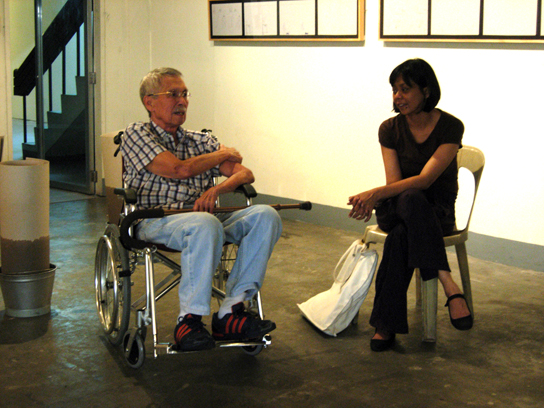
What are some of the problems that you’ve encountered in trying to represent as well as revisit something as intangible as a history of conceptual art?
Conceptual art in the Philippines, I believe, hasn’t been studied or written about adequately. There are really very few public records or sources of information. Chabet has also been very elusive, and chooses very carefully the people he will work with. This has been frustrating for some, and perhaps this has negatively influenced the way they see him. (Like the hungry fox that calls the grapes sour just because he can’t reach it.)
I think biases towards a more ‘nationalistic’ form of art after 1986 have also influenced the course of things. Often dismissed as a borrowed ‘Western’ idea, conceptual art has little support from state-funded programs post Marcos. I remember in school, in my Art History class, it was rarely mentioned, as if it wasn’t part of our history. Of course, outside the classroom, it was happening all over.
Up to now, I still feel the tensions brought on by this decades-long rift. It is difficult to bridge, but I hope, with this exhibit, I can start a dialogue on a subject that needs to be addressed; and not simply written off because of some political agenda, or worse, because of personal grievances.
Does it run the risk of becoming too hermetic or esoteric an exercise?
Any discussion on conceptual art will likely tend to be esoteric or lofty mainly because we are dealing with ideas and philosophies. Conceptual art questions mainstream notions on art; hence it is not a populist view. That however, is not a reason to silence it.
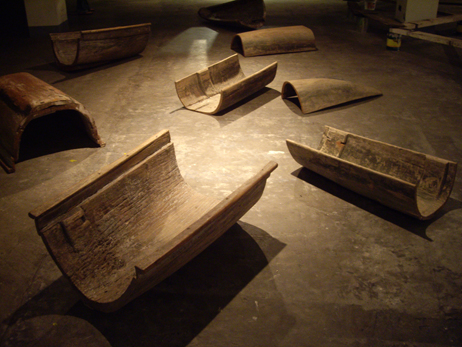
What are some of the visual languages or vocabularies you’ve used to complement the archival compulsion in this exhibition?
Reconstructing some of Chabet’s works for this exhibition is a kind of retrieval, just like archiving. It was challenging basically because they never existed, or they were not documented. I had to visualize it and map it out in my head based on his stories or descriptions. In the process of recollection and translation, there are, naturally, some discrepancies. Just like the way we remember, it is not always accurate, details are lost, and only the essences remain.
An integral part of this exhibition is that it can only be viewed from behind a glass door. It is a framing device that signifies a particular point of view, or way into looking at the works. It delineates space, separating the viewer from the area occupied by the works. Just like Chabet’s mind, it is clear and visible, but not necessarily easy to enter.
In what can be described as the information age, where we are currently inundated with a surfeit of information, what role do you see a ‘critical’ archivist play in addressing this issue?
A critical archivist’s role is to sift through all these data and choose what’s worth keeping. We have to select, for many reasons. It is a delicate position and inevitably runs the risk of being criticized as a kind of canon or myth-making. It is a powerful tool because it is able to shape history and collective memory. Of course, we have to be aware of how, when and by whom the records are made.
(SS)
Sorry, the comment form is closed at this time.
Thanks Simon for the interview with Ringo, I like the project. Any plan to have similar study on conceptual art/approach/tendency in Malaysia?
i was told, AAA will soon be doing a similar kind of research/archiving of Ray’s collections of performance-videos in this region. That should be interesting to see.
Hello guys!
Sau Bin: Glad you enjoyed it, the project was quite an eye-opener for me too. The ball’s probably in your court in terms of conceptual practices in Malaysia! :p but yes, I’m currently looking into some of Redza’s stuff that can still be discussed. I don’t think people understand what he was doing back then enough to truly appreciate him more than a callous idea of Redza as the trickster and provocateur.
Vincent: That’s great news! Ray didn’t tell me that -_- I would love to have a look through his collection. Hehehe, lemme go bug him.
My mother drew a distinction between achievement and success. She said that ‘achievement is the knowledge that you have studied and worked hard and done the best that is in you. Success is being praised by others, and that’s nice, too, but not as important or satisfying. Always aim for achievement and forget about success.’